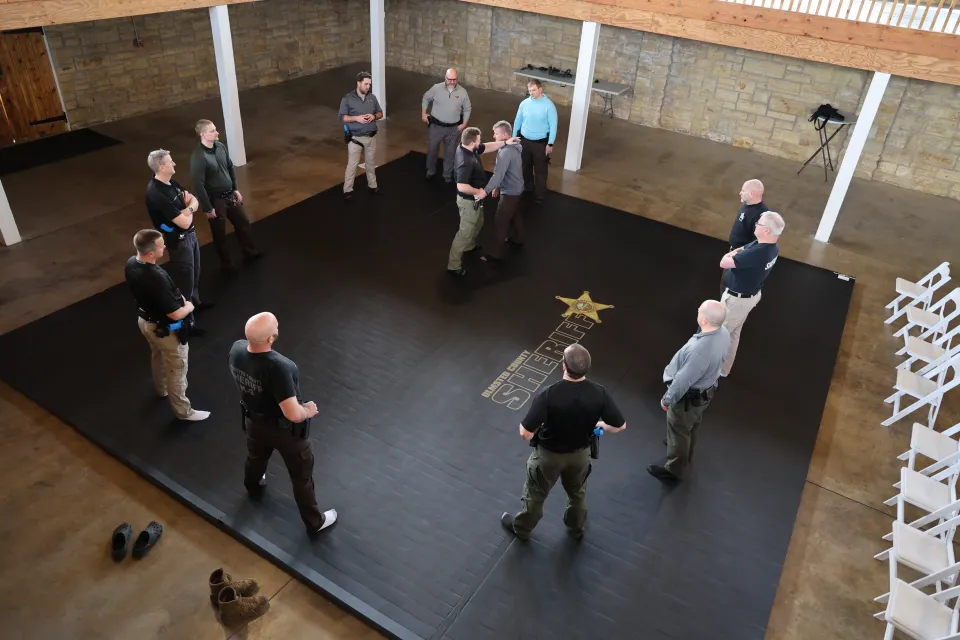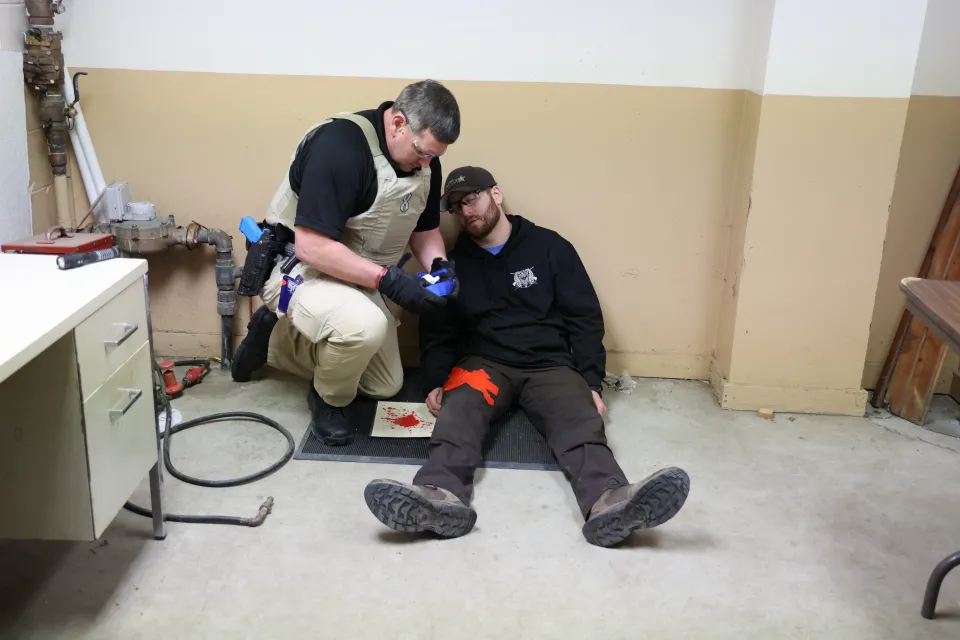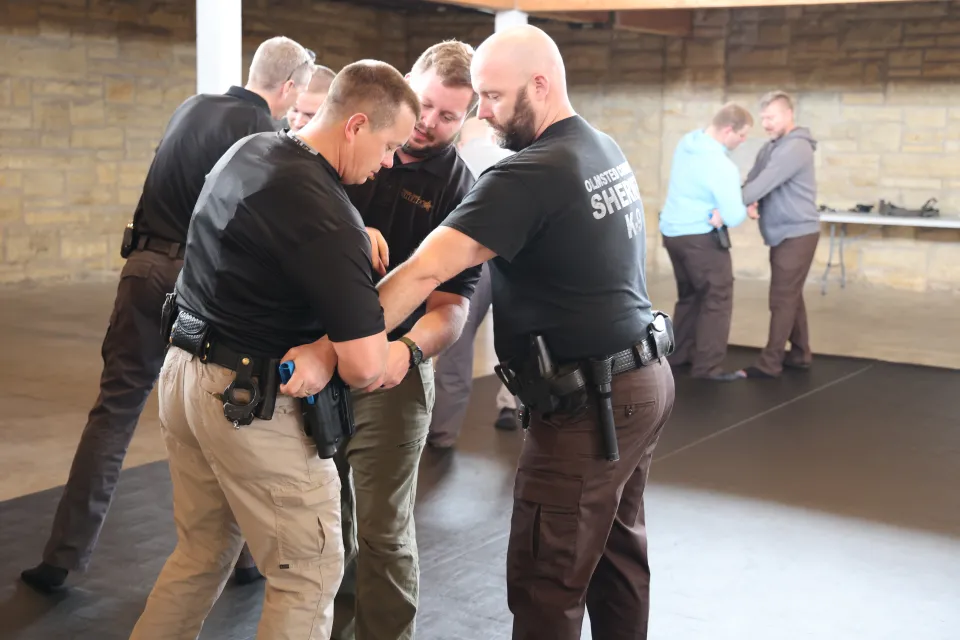April 2024 Newsletter (Volume 10, Issue 4)
April 2024 Newsletter (Volume 10, Issue 4)
Please click on the title below to view each of the different stories in the newsletter.

A Note from Sheriff Torgerson
As the months and years tick by, it is common to overlook the core aspects of our profession. In this issue we touch on the training our Office participates in and quite frankly has been a leader in some aspects for many years regionally and nationally. We work on the training we provide to our staff led by our core values of dedication, integrity, honor, duty, and courage. It is common to hear an instructor in training events remind staff to focus on the training as if it was real. For as long I can recall, the Olmsted County Sheriff’s Office training has far exceeded the requirements of the guiding boards that dictate policies, training needs, and credits. Even when the legislature makes sudden changes to mandates, our training staff is quick to respond and ready to incorporate new thoughts and ideas into the next opportunity.
With that said, we can always do more. We stress to our training staff and volunteer instructors to always be looking for new options and tactics to incorporate with our deputies.
My hope as you read this is that you will be encouraged by what you see and trust that our Office is doing everything possible to make our communities a better and safer place each day. I couldn’t be more proud of our staff and this agency.
Maximizing Efficiency and Risk Mitigation: The Case for Comprehensive
In-Service Training
Deputy Mike Strelow, Staff Training and Emergency Management
In today's rapidly evolving social and technological landscape, law enforcement continues to face unprecedented challenges and opportunities. The role of law enforcement agencies has expanded far beyond traditional response, investigation, and crime prevention to encompassing a wide array of responsibilities ranging from maintaining public safety to addressing complex socio-economic issues facing their communities. This raises the question; how do we continually provide relevant and engaging training for our Deputies to ensure the best possible outcomes for them and our community? Approximately fifteen years ago, some of our veteran Deputies may remember a time when training consisted of one, maybe two, 8 to 10-hour annual sessions. Deputies completed use of force training, legal updates, and other pertinent concepts wrapped into one package. Firearms training was limited, and qualifications were completed while on shift or during a brief pre-arranged time outside of normal shift hours. Currently, our in-service training is completed quarterly, allowing us 10 to 12 hours every three months to focus on numerous concepts, both mandated and non-mandated by the Minnesota Peace Officer Standards and Training (POST). With that being said, we continue to look for solutions and ideas to go above the state standard of 48 hours of continuing education every three years. Our Office does an exceptional job at surpassing this mark with the average Deputy nearing approximately 350 hours of training in a three-year period.

Fact-Driven, Science-Based
The Training Division strives to provide training that is fact-driven and science-based. Looking at statistics and national trends is a great start when we decide which concepts should be the focus of training for our Deputies. Organizations such as the FBI Peace Officer Safety Institute, Law Enforcement Officers Killed and Assaulted (LEOKA), and Force Science are great resources that analyze officer safety data, review critical law enforcement incidents, and present realistic training to enhance peace officer performance during unanticipated, high stress, and rapidly changing incidents. For instance, we know through LEOKA that 70% of all officer-involved shooting incidents occurred in low-light conditions. Statistically, if peace officers are more likely to become injured or assaulted in this environment, shouldn’t we focus our use of force program in this direction? This is also consistent with our internal data showing approximately 61% of use of force incidents occurred in low-light conditions. In addition, data shows the correlation between high-risk incidents and the requirement for more training. As risks escalate (ie: high-risk vehicle stops), the demand for comprehensive training programs intensifies to equip individuals with the necessary skills and knowledge to effectively mitigate those risks.

Long Term Investment
While sending all staff to an external training program may seem convenient, conducting in-house training offers several cost-saving advantages. One of these advantages is creating subject matter experts in selected training such as Firearms, Use of Force, Field Training, and Crisis Intervention. Long term, we establish consistent programs for our members as well as offer them a resource for continual education. This also provides the customization and flexibility for what best fits our Office needs. Finally, we can establish standard operating procedures for all members which enhances team dynamics and effectiveness in a safer environment. This minimizes the likelihood of errors, accidents, and legal liabilities. Regular reinforcement of these standards through quarterly training reduces organizational risks.

Severe Weather Awareness Week is April 8 - 12, 2024
Are you ready for severe weather? Each year, HSEM in collaboration with the National Weather Service sponsors Severe Weather Awareness Week in Minnesota. The week is designed to refresh, remind and educate everyone about the seasonal threats from severe weather and how to avoid them. It's also a great time to make and practice your emergency plan and build or refresh your emergency preparedness kit. If you are interested in some ideas on how you, your family, business, or your community can participate in Severe Weather Awareness Week, check out some ideas on this list.
The National Weather Service will provide Storm Spotter training on April 23. The event is free and open to anyone interested in severe weather. No registration is necessary.
Tuesday, April 23, 2024 - Olmsted County - 6:30 PM to 8:30 PM
1517 16th St SW, Rochester, MN 55902
Venue: Empire Event Center
Monthly Snapshot: 2023 LEC Training Statistics
Deputy Mike Strelow
- 9,886 Hours – Training Received by Deputies
- 115 Hours - Average per Deputy
- 6,886 Hours – MN POST Certified Trainings
- 80 Hours – Average per Deputy
- 3,000 Hours – Non-Post Training (Instructor courses, range training, scenario-based)
- 35 Hours - average per Deputy
Typically, external courses cost $50 per hour per Deputy. Some courses are more and that depends on content experts and presenters. Some courses are free. Some courses are over multiple days and require hotel and meal reimbursements. If we use the simple number above ($50 per hour) and multiply it by the total number of training hours, the total is $494,300.00. This does not include hotel and meal reimbursement expenses. In 2023, the Olmsted County Sheriff’s Office spent approximately $120,000 on training and all associated expenses. Our best estimate is that by providing high-quality internal training, the Sheriff’s Office saves taxpayers nearly a half-million dollars every year.
Dates of Interest
April 1
Oronoco Township Meeting
Pleasant Grove Township Meeting
Quincy Township Meeting
Rochester City Council Meeting
April 2
Elmira Township Meeting
High Forest Township Meeting
Olmsted County Board Meeting
April 3
Salem Township Meeting
April 4
Dover City Council Meeting
April 8
Cascade Township Meeting
Chatfield City Council Meeting
Orion Township Meeting
Rock Dell Township Meeting
April 9
Byron City Council Meeting
Marion Township Meeting
New Haven Township Meeting
Stewartville City Council Meeting
April 11
Eyota City Council Meeting
Rochester Township Meeting
April 15
Eyota Township Meeting
Kalmar Township Meeting
Oronoco City Council Meeting
Rochester City Council Meeting
April 16
Farmington Township Meeting
Olmsted County Board Meeting
Pine Island City Council Meeting
April 17
Haverhill Township Meeting
April 22
Chatfield City Council Meeting
Viola Township Meeting
April 23
Byron City Council Meeting
Stewartville City Council Meeting
Storm Spotter Training
April 25
Eyota City Council Meeting
Olmsted County Fire Meeting
Olmsted County Township Association Meeting
April 29
Dover Township Meeting
Senior Administration
Sheriff
Kevin Torgerson
Chief Deputy—LEC
Brian Howard
Captains
Jon Jacobson
Kelly Lee
Ryan Mangan
Tim Parkin
Chris Wallace
Executive Assistant
Laura Collins
Chief Deputy—ADC
James Schueller
Captains
David Adams
Samantha Reps
Macey Tesmer
